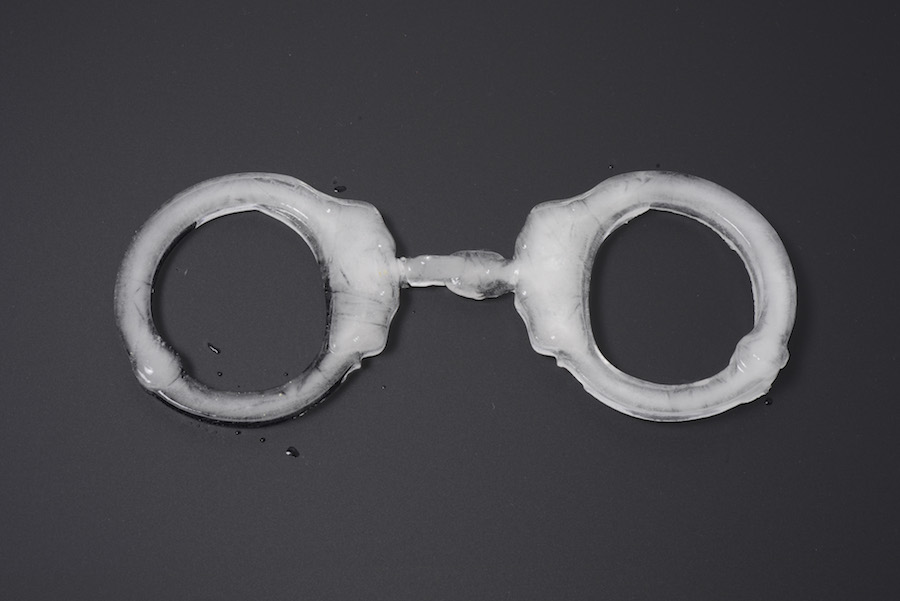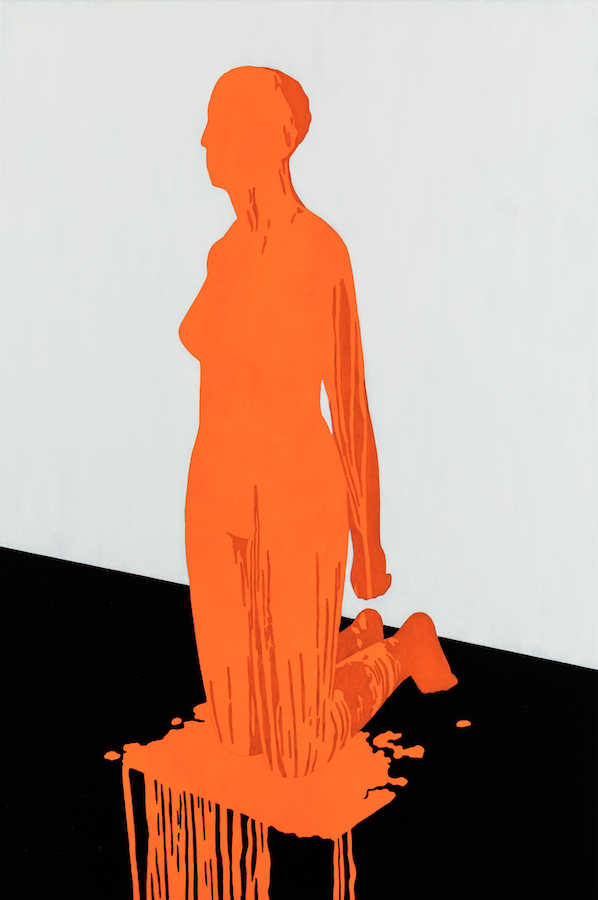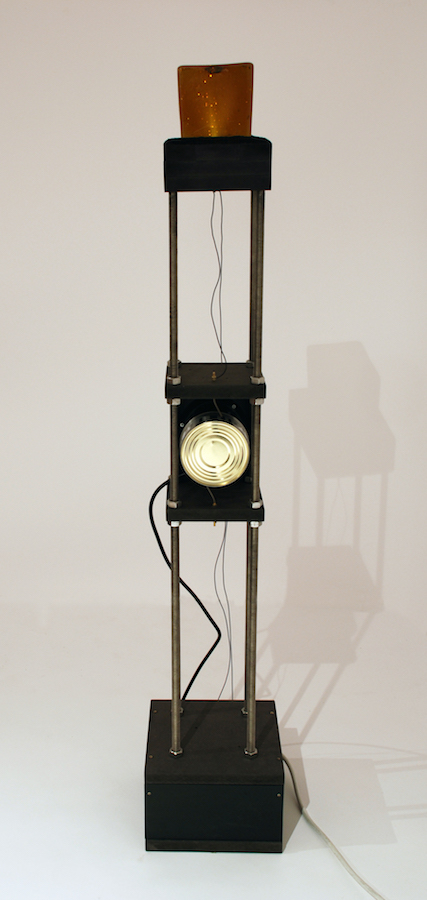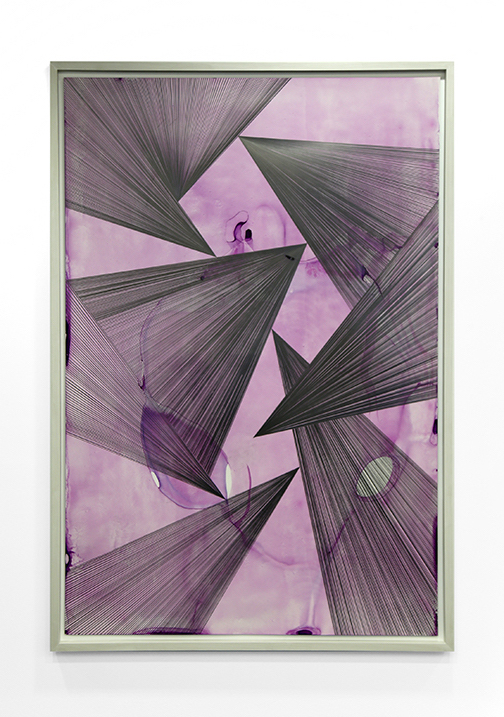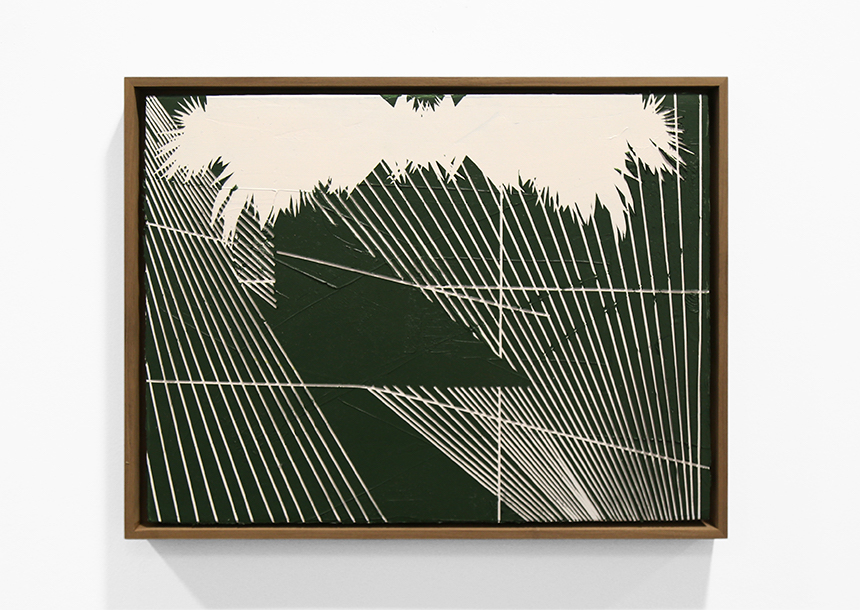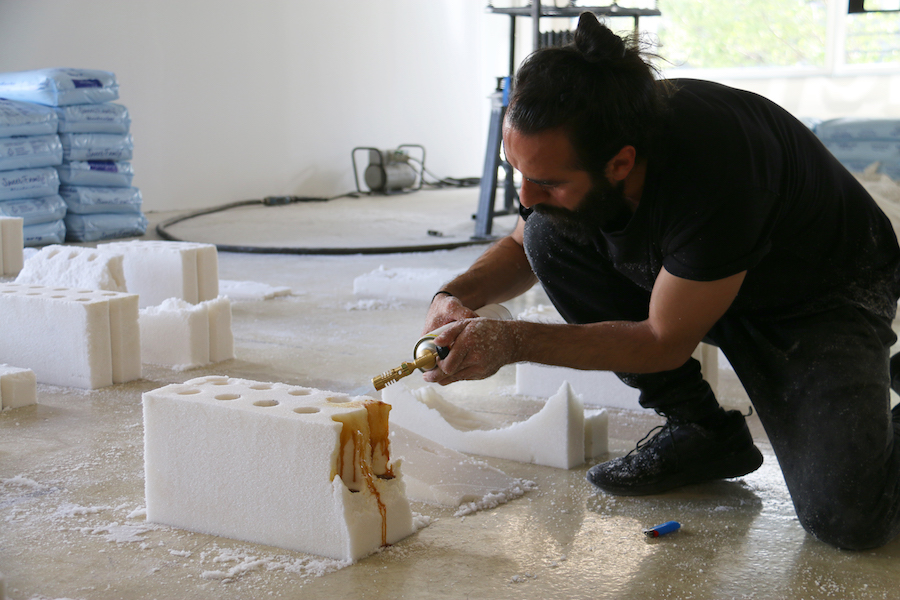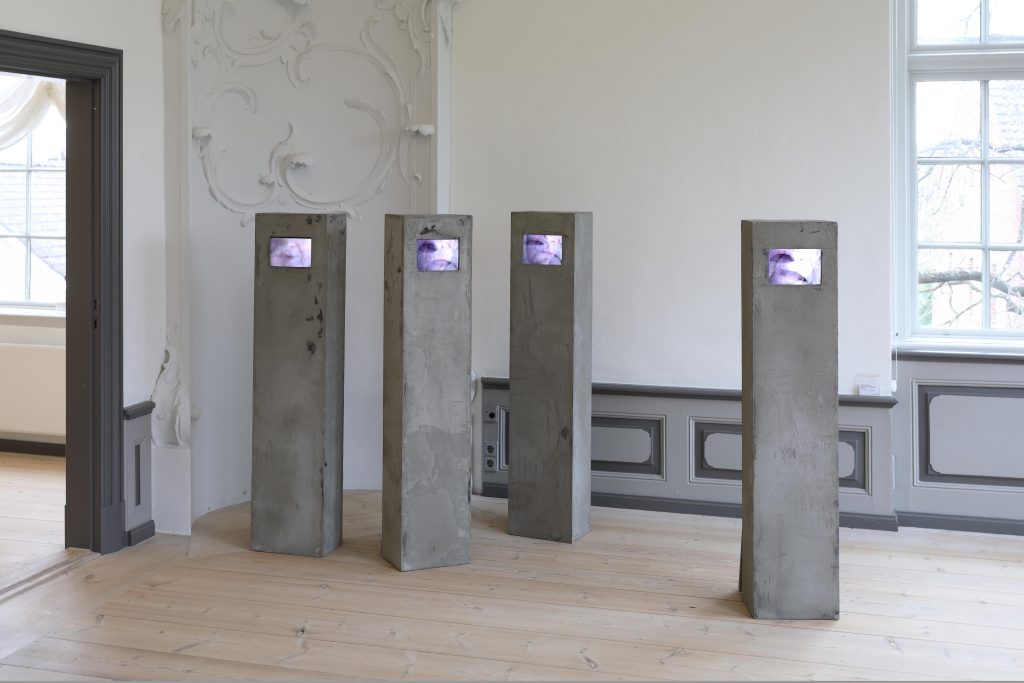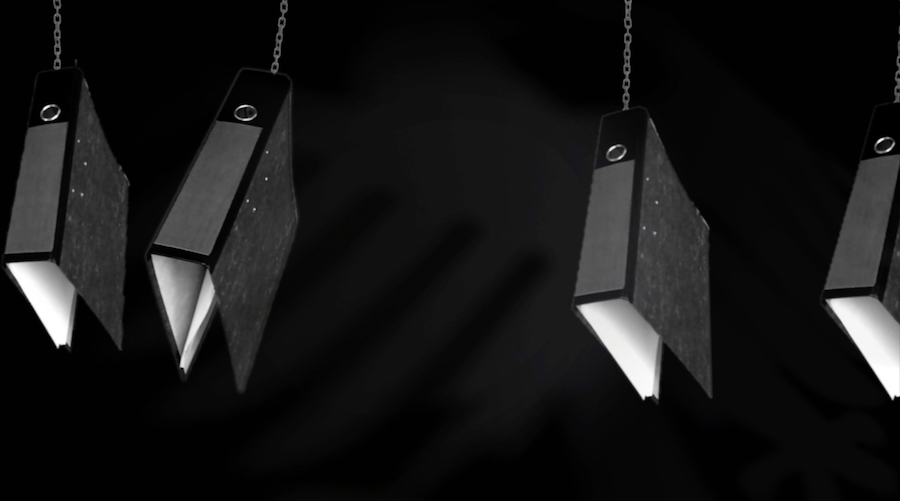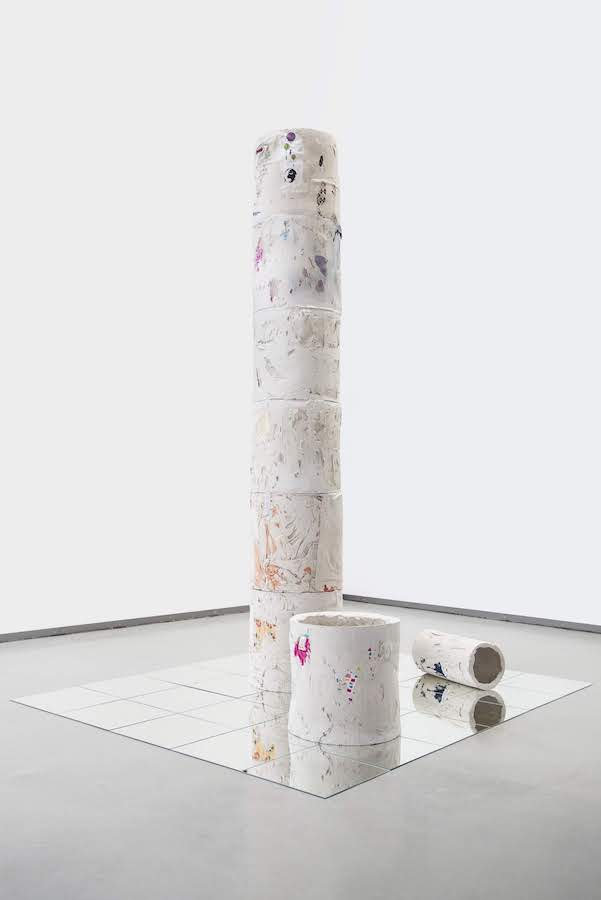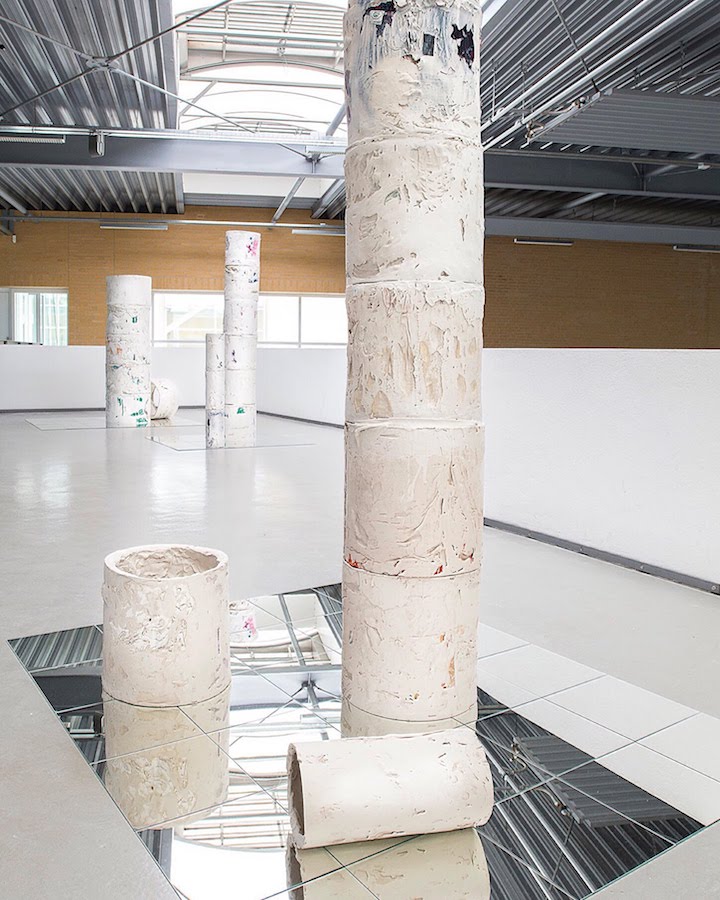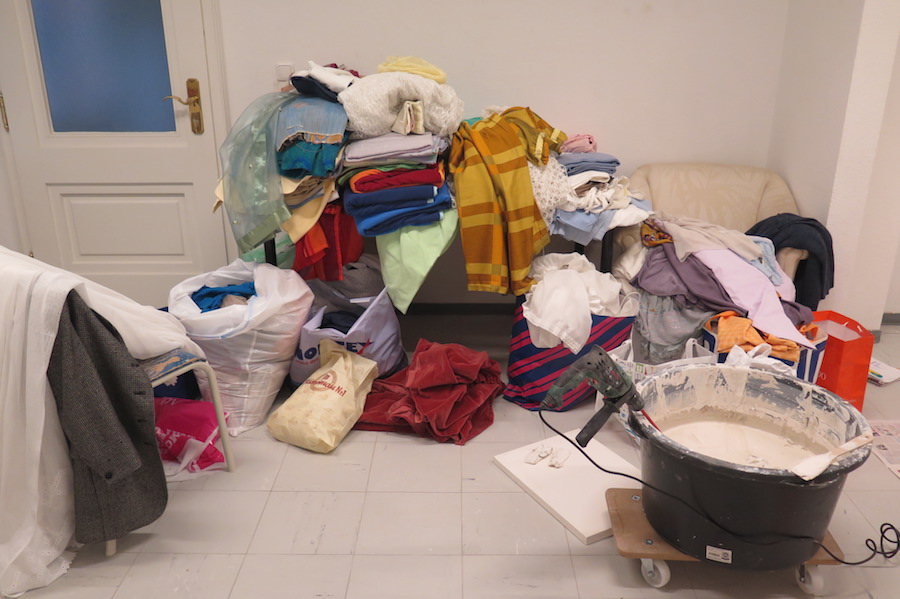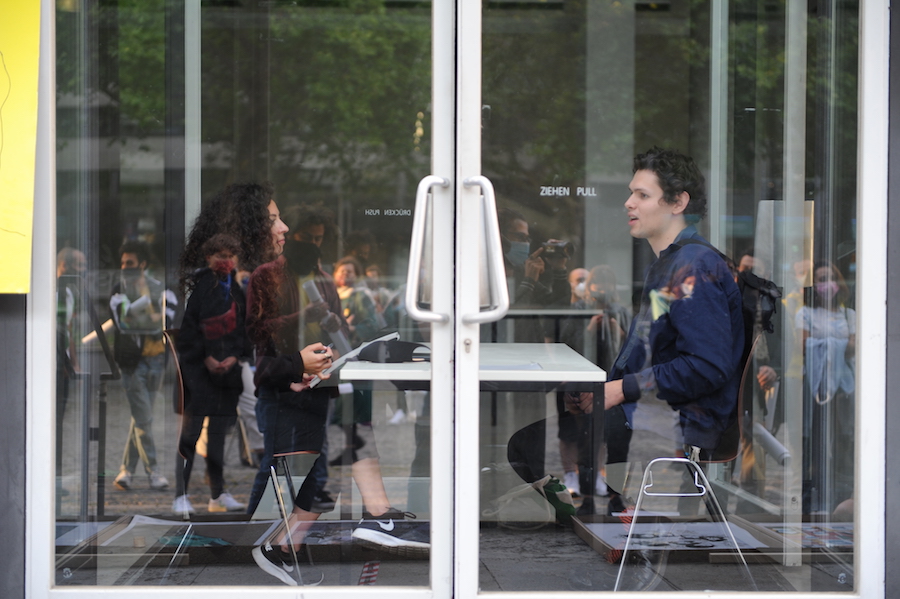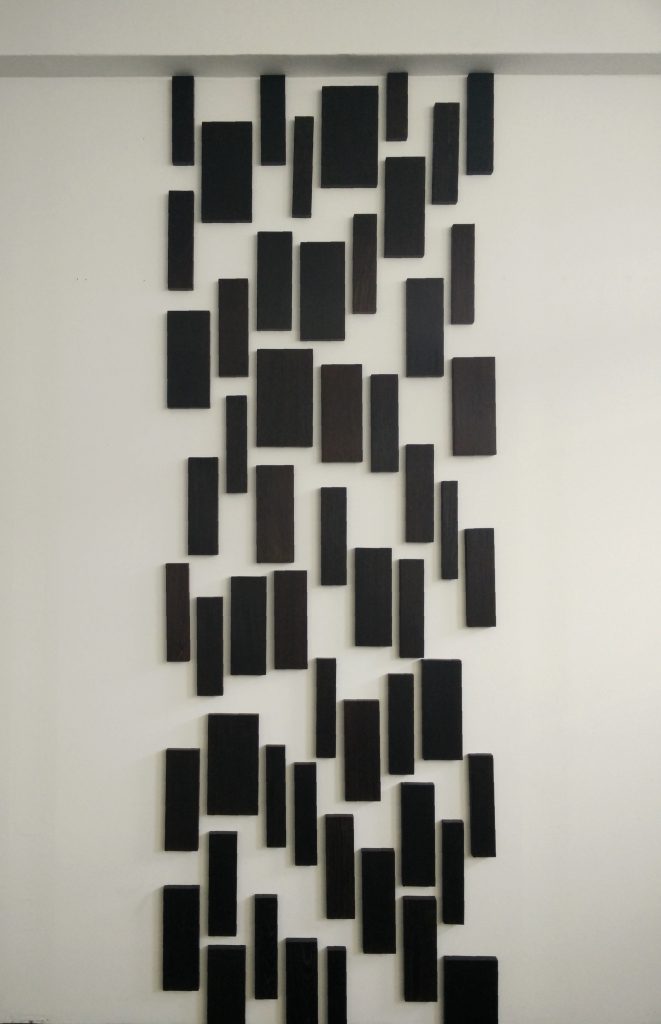[spb_text_block animation=“none“ animation_delay=“0″ simplified_controls=“yes“ custom_css_percentage=“no“ padding_vertical=“0″ padding_horizontal=“0″ margin_vertical=“0″ custom_css=“margin-top: 0px;margin-bottom: 0px;“ border_size=“0″ border_styling_global=“default“ width=“1/1″ el_position=“first last“]
STATE OF THE ART 2020
5. September bis 31. Oktober 2020
Die Ausstellung STATE OF THE ART 2020 ist ab dem 1. November nur noch als Textblog mit Abbildungen verfügbar. Wenn Sie auch nach Ende der Ausstellungslaufzeit Interesse an dem virtuellen Rundgang haben, kontaktieren Sie uns bitte per Email: kontakt (at) galeriepostel.de
Die Textversion der Ausstellung bleibt weiterhin bestehen -für den vollen Genuss klicken Sie gerne auf die Bilder, hinter einigen verbergen sich Videos oder Diashows, die zeitliche Abläufe oder verschiedene Ansichten abbilden.
Wo innerhalb des Textes Links angeboten werden, verlinken sie zu vorhergegangenen Ausstellungen der Künstler in der Galerie.
Die Arbeiten sind in alphabetischer Reihenfolge der Künstlernamen gelistet
Fragen? Wir helfen gerne!
kontakt (at) galeriepostel.de
Tel.: +49-40-22 85 39 24 – 0
für weitere Informationen über Arbeit, Künstlerbiografie oder Preisen bis hin zu weiteren Materialien
[/spb_text_block] [spb_text_block animation=“none“ animation_delay=“0″ simplified_controls=“yes“ custom_css_percentage=“no“ padding_vertical=“0″ padding_horizontal=“0″ margin_vertical=“0″ custom_css=“margin-top: 0px;margin-bottom: 0px;“ border_size=“0″ border_styling_global=“default“ width=“1/1″ el_position=“first last“]
Amer Al Akel
Melting their Power, 2020
Lentikulardruck
60 x 90 cm
Bitte klicken Sie auf das Bild, um das Video zu starten!
[/spb_text_block] [spb_blank_spacer height=“30px“ width=“1/1″ el_position=“first last“] [spb_text_block animation=“none“ animation_delay=“0″ simplified_controls=“yes“ custom_css_percentage=“no“ padding_vertical=“0″ padding_horizontal=“0″ margin_vertical=“0″ custom_css=“margin-top: 0px;margin-bottom: 0px;“ border_size=“0″ border_styling_global=“default“ width=“1/1″ el_position=“first last“]
[/spb_text_block] [spb_blank_spacer height=“30px“ width=“1/1″ el_position=“first last“] [spb_text_block animation=“none“ animation_delay=“0″ simplified_controls=“yes“ custom_css_percentage=“no“ padding_vertical=“0″ padding_horizontal=“0″ margin_vertical=“0″ custom_css=“margin-top: 0px;margin-bottom: 0px;“ border_size=“0″ border_styling_global=“default“ width=“1/1″ el_position=“first last“]
Ari Goldmann
Weep, 2020
Öl und Acryl auf Leinwand
80 x 120 cm
[/spb_text_block] [spb_blank_spacer height=“30px“ width=“1/1″ el_position=“first last“] [spb_text_block animation=“none“ animation_delay=“0″ simplified_controls=“yes“ custom_css_percentage=“no“ padding_vertical=“0″ padding_horizontal=“0″ margin_vertical=“0″ custom_css=“margin-top: 0px;margin-bottom: 0px;“ border_size=“0″ border_styling_global=“default“ width=“1/1″ el_position=“first last“]
Sie kniet an einer Kante, augenscheinlich nackt und doch in Konturen und Gesichtszügen kaum erkennbar, nass, von irgendetwas, das in leuchtendem Neonorange an ihr herunter rinnt. Welche Situation finden wir vor? Warum kniet sie? Wurde sie verletzt? Was rinnt an ihr herunter und warum hat sie nicht die Arme gehoben, als sie so offenkundig von irgendetwas – Nässe, Gewalt – getroffen wurde? Diese sind hinter ihrem Rücken heruntergestreckt, schutzlos ergeben präsentiert sie sich und bietet sich dem Gegenüber an – unfähig, wegzulaufen oder abzuwehren. Tut sie dies freiwillig? Wurde sie gezwungen? Ari Goldmanns Bild lässt uns im Ungewissen über die Situation.
Die Vorlage dieses Gemäldes ist anders als bei Goldmanns meisten anderen Bildern nicht ein Medienkontext. Greift er sonst oft auf Bildikonen einer bestimmten historischen Situation zurück, die in der Presse und in Geschichtsbüchern für die Berichterstattung benutzt werden, und reflektiert so über archetypische Ikonografien, die sich in das kollektive Gedächtnis eingebrannt haben, ist es diesmal ein selbst aufgenommenes Foto.
Es entstand vor ca. einem Jahr, als auf die Skulptur der „Großen Knieenden“ von Georg Seitz an der Hamburger Alster ein Farbanschlag verübt worden war. Die Skulptur kniet an einem Ende einer Sitzbank an der Flanierstrecke auf dem westlichen Alsterufer in der Nähe des beliebten Naherholungsgebietes Alsterwiesen. Dort überragt sie kniend die Sitzenden, die auf den Bänken Platz nehmen. Doch der Angriff lässt die Geste der Passivität weniger freiwillig erscheinen und rückt etwas, was vielleicht Anfang der 60er, als die Skulptur gefertigt wurde, noch positiv gewertet wurde, in einem anderen Licht erscheinen. Wo kniet man so ergeben, während einem Gewalt angetan wird?
Weep – der Titel steht für das Maß der Traurigkeit, das der Künstler in dieser Situation sieht. Wie auch in seinen anderen Arbeiten blendet Goldmann den Kontext, orts- und zeitspezifische Merkmale, auch das zum Farbanschlag auf der Bank selbst angebrachte Graffiti und seine politische Ausrichtung, aus und reduziert die Figur auf ihre Konturen. So kristallisiert er die eine Geste, das ikonische Moment heraus, die universell wiedererkennbar wird.
Es ist nicht der Moment der Beschmutzung dieser einen Skulptur an einem spezifischen Ort in Hamburg, es ist die Grundsätzlichkeit von Gewalt und Passivität, von Ergebenheit, Ausgeliefertsein und Trauer angesichts der Gewalt, die in leuchtendem Neonorange als starker Kontrast zum schwarz-weiß der Bildumgebung hervorsticht.
[/spb_text_block] [spb_blank_spacer height=“30px“ width=“1/1″ el_position=“first last“] [spb_text_block animation=“none“ animation_delay=“0″ simplified_controls=“yes“ custom_css_percentage=“no“ padding_vertical=“0″ padding_horizontal=“0″ margin_vertical=“0″ custom_css=“margin-top: 0px;margin-bottom: 0px;“ border_size=“0″ border_styling_global=“default“ width=“1/1″ el_position=“first last“]
Kathrin Haaßengier
liebelebe, 2020
Holz, Metall, Glas, Glühbirne, Motor
[/spb_text_block] [spb_blank_spacer height=“30px“ width=“1/1″ el_position=“first last“] [spb_text_block animation=“none“ animation_delay=“0″ simplified_controls=“yes“ custom_css_percentage=“no“ padding_vertical=“0″ padding_horizontal=“0″ margin_vertical=“0″ custom_css=“margin-top: 0px;margin-bottom: 0px;“ border_size=“0″ border_styling_global=“default“ width=“1/1″ el_position=“first last“]
[/spb_text_block] [spb_blank_spacer height=“30px“ width=“1/1″ el_position=“first last“] [spb_text_block animation=“none“ animation_delay=“0″ simplified_controls=“yes“ custom_css_percentage=“no“ padding_vertical=“0″ padding_horizontal=“0″ margin_vertical=“0″ custom_css=“margin-top: 0px;margin-bottom: 0px;“ border_size=“0″ border_styling_global=“default“ width=“1/1″ el_position=“first last“]
Simon Halfmeyer
[/spb_text_block] [spb_text_block animation=“none“ animation_delay=“0″ simplified_controls=“yes“ custom_css_percentage=“no“ padding_vertical=“0″ padding_horizontal=“0″ margin_vertical=“0″ custom_css=“margin-top: 0px;margin-bottom: 0px;“ border_size=“0″ border_styling_global=“default“ width=“1/2″ el_position=“first“]
splinter 02/20, 2020
Aquarell und Grafit auf Schichtpapier
121 x 181 cm, gerahmt
[/spb_text_block] [spb_text_block animation=“none“ animation_delay=“0″ simplified_controls=“yes“ custom_css_percentage=“no“ padding_vertical=“0″ padding_horizontal=“0″ margin_vertical=“0″ custom_css=“margin-top: 0px;margin-bottom: 0px;“ border_size=“0″ border_styling_global=“default“ width=“1/2″ el_position=“last“]
o.T., 2019
Öl auf Leinwand
30 x 40 cm
[/spb_text_block] [spb_blank_spacer height=“30px“ width=“1/1″ el_position=“first last“] [spb_text_block animation=“none“ animation_delay=“0″ simplified_controls=“yes“ custom_css_percentage=“no“ padding_vertical=“0″ padding_horizontal=“0″ margin_vertical=“0″ custom_css=“margin-top: 0px;margin-bottom: 0px;“ border_size=“0″ border_styling_global=“default“ width=“1/1″ el_position=“first last“]
In seinen jüngsten Arbeiten setzt Simon Halfmeyer die beiden Arbeitsstränge fort, die bereits in den vergangenen Ausstellungen in der galerie postel „Wandzeichnungen“ (2014) und „Expetopia“ (2016) zu sehen waren: Die Konstruktion von Wildnis im urbanen Raum als Thema seiner gegenständlichen Zeichnungen und die Zeichnung als Träger formatfüllender Abstraktion als „all over“.
Simon Halfmeyers erstes Medium ist die Zeichnung, die er in den unterschiedlichsten Medien erprobt. Abstrakte Graphitzeichnungen und Aquarell auf einem papierähnlichen Schichtstoff in einem wandfüllenden Format 181 x 121 cm, das dem Betrachter ein Erlebnis des physischen Gegenübers verschafft, das sonst eher in der Malerei erwartet wird.
Seine eher gegenständlichen Arbeiten sind eine Reise in die Wildnis des urbanen Raumes. Ihre Elemente entstammen einem sich ständig im Wandel befindenden, umfassenden Archiv aus hunderten Abbildungen, di in anderen Werken wiederkehren. Palmen und exotische Gewächse aus Foyers, Gewächshäusern, Flughäfen oder Shopping Malls stehen für die Fiktion einer Wildnis als Konstrukt der Zivilisation, die durch die Gegenüberstellung mit urbaner Architektur und städtischen Elementen wie Ampeln, Laternen oder Hochhäusern sichtbar gemacht werden.
Sie sind wandfüllend wie Freskomalerei direkt auf der Wand, werden als Farbreliefs zum Tafelbild oder als Skulpturen in die dritte Dimension überführt. Eine Arbeit dient als Vorlage der nächsten, Elemente werden übernommen und weiterverarbeitet, um dann wieder Eingang in das Archiv zu finden oder erneut, gleich dem Sampling Verfahren, zur Vorlage zu werden, organisch, wie das pflanzliche Wachstum.
Die abstrakte Serie von „Stars“ bringt mehr als die durch technische Hilfsmittel bearbeiteten Zeichnungen von Palmen und Pflanzen die „Hand des Künstlers“ ins Spiel. Er zeichnet die Linien, mit dem Lineal als Gegensatz zum Organischen seiner Pflanzenbilder, und sorgt mit der gleichmäßigen Weiterbewegung des Lineals für den Rhythmus des Bildes. Ein angesichts der Bildgröße sehr physischer Vorgang bei vollem Körpereinsatz.
[/spb_text_block] [spb_blank_spacer height=“30px“ width=“1/1″ el_position=“first last“] [spb_text_block animation=“none“ animation_delay=“0″ simplified_controls=“yes“ custom_css_percentage=“no“ padding_vertical=“0″ padding_horizontal=“0″ margin_vertical=“0″ custom_css=“margin-top: 0px;margin-bottom: 0px;“ border_size=“0″ border_styling_global=“default“ width=“1/1″ el_position=“first last“]
Fadi al Hamwi
Sugar Forever, 2019
Performance, CAA Berlin
Bitte klicken Sie auf das Bild, um die Diashow zu starten!
[/spb_text_block] [spb_blank_spacer height=“30px“ width=“1/1″ el_position=“first last“] [spb_text_block animation=“none“ animation_delay=“0″ simplified_controls=“yes“ custom_css_percentage=“no“ padding_vertical=“0″ padding_horizontal=“0″ margin_vertical=“0″ custom_css=“margin-top: 0px;margin-bottom: 0px;“ border_size=“0″ border_styling_global=“default“ width=“1/1″ el_position=“first last“]
Wer Fadi al-Hamwis Performance „Sugar Forever“ im April 2019 bei CAA Berlin verpasst hat, bekommt nun die Gelenheit, sie bei STATE OF THE ART noch mal als Diashow zu sehen. Hier verarbeitete er zahlreiche Zentner Zucker in ca. 10 Tagen in Steine, die in ihrer Form der gängigen Form des Baumaterials für Häuser in Syrien entsprechen.
Die Ausmaße der Aktion sind Spiegel ihres Inhaltes. Denn bei dem Stichwort Zucker geht es Fadi al Hamwi um zwei eng damit verbundene Aspekte: Die Geschichte der Zuckerproduktion, des Kolonialismus und seiner Folgen, unter denen Migration, Völkerwanderung oder Flucht, sei es vor Krieg oder Hunger.
All diesen Neuankommenden ist die Notwendigkeit, ihren Platz zu finden im System – das durch die Steine verkörperte Haus – des Ankunftslandes. Tausende, Millionen kleiner Zuckerkörnchen werden in al Hamwis Performance in baufähige Form gepresst, eigenhändig mit einer Handpresse durch den Künstler als strukturierende und gestaltende Kraft.
Doch der Prozess ist nicht einfach, es bröselt, Feuchtigkeit schwächt die Integrität der Zuckersteine und die Bearbeitung mit dem Bunsenbrenner – ebenfalls durch den Künstler – hinterlässt hässliche Brandspuren im cleanen Weiß des Industriezuckers.
Mit dieser Performance setzt Fadi al-Hamwi die Arbeit an den Themen fort, die er schon in der IN BETWEEN Ausstellung in der galerie postel 2018/19 vorgestellt hat, wo er ein aus Zucker gepresstes Buch präsentierte, dessen Cover die Prägung „Poisoned History“ trug. Migration, Flucht und die Folgen der Ankunft in einer neuen Gesellschaft wurden auch in seiner Arbeit „Irrational Loop of Dust“ reflektiert und in der Performance „Sugar Forever“ heute zusammengeführt.
[/spb_text_block] [spb_blank_spacer height=“30px“ width=“1/1″ el_position=“first last“] [spb_text_block animation=“none“ animation_delay=“0″ simplified_controls=“yes“ custom_css_percentage=“no“ padding_vertical=“0″ padding_horizontal=“0″ margin_vertical=“0″ custom_css=“margin-top: 0px;margin-bottom: 0px;“ border_size=“0″ border_styling_global=“default“ width=“1/1″ el_position=“first last“]
Sylvia Henze
Breaking the Mould, 2015
Videoinstallation, 1:21 Min. Loop
Tablet, Holz, Zement
146 x 31 x 22 cm
Bitte klicken Sie auf das Bild, um das Video zu starten!
[/spb_text_block] [spb_blank_spacer height=“30px“ width=“1/1″ el_position=“first last“] [spb_text_block animation=“none“ animation_delay=“0″ simplified_controls=“yes“ custom_css_percentage=“no“ padding_vertical=“0″ padding_horizontal=“0″ margin_vertical=“0″ custom_css=“margin-top: 0px;margin-bottom: 0px;“ border_size=“0″ border_styling_global=“default“ width=“1/1″ el_position=“first last“]
[/spb_text_block] [spb_blank_spacer height=“30px“ width=“1/1″ el_position=“first last“] [spb_text_block animation=“none“ animation_delay=“0″ simplified_controls=“yes“ custom_css_percentage=“no“ padding_vertical=“0″ padding_horizontal=“0″ margin_vertical=“0″ custom_css=“margin-top: 0px;margin-bottom: 0px;“ border_size=“0″ border_styling_global=“default“ width=“1/1″ el_position=“first last“]
Katharina Kohl
Erinnerungslücken / Innere Sicherheit #2, 2020
Dauer: 4:22:11 Minuten
Bitte klicken Sie auf das Bild, um das Video zu starten!
[/spb_text_block] [spb_blank_spacer height=“30px“ width=“1/1″ el_position=“first last“] [spb_text_block animation=“none“ animation_delay=“0″ simplified_controls=“yes“ custom_css_percentage=“no“ padding_vertical=“0″ padding_horizontal=“0″ margin_vertical=“0″ custom_css=“margin-top: 0px;margin-bottom: 0px;“ border_size=“0″ border_styling_global=“default“ width=“1/1″ el_position=“first last“]
[/spb_text_block] [spb_blank_spacer height=“30px“ width=“1/1″ el_position=“first last“] [spb_text_block animation=“none“ animation_delay=“0″ simplified_controls=“yes“ custom_css_percentage=“no“ padding_vertical=“0″ padding_horizontal=“0″ margin_vertical=“0″ custom_css=“margin-top: 0px;margin-bottom: 0px;“ border_size=“0″ border_styling_global=“default“ width=“1/1″ el_position=“first last“]
Danijela Pivašević-Tenner
Triumphsäulen, 42 Szenen der Gegenwart
Installation im Museum Tuch + Technik, Neumünster 2019
ungebranntes Porzellan, Textilien, Spiegel
[/spb_text_block] [spb_blank_spacer height=“30px“ width=“1/1″ el_position=“first last“] [spb_text_block animation=“none“ animation_delay=“0″ simplified_controls=“yes“ custom_css_percentage=“no“ padding_vertical=“0″ padding_horizontal=“0″ margin_vertical=“0″ custom_css=“margin-top: 0px;margin-bottom: 0px;“ border_size=“0″ border_styling_global=“default“ width=“1/1″ el_position=“first last“]
[/spb_text_block] [spb_blank_spacer height=“30px“ width=“1/1″ el_position=“first last“] [spb_text_block animation=“none“ animation_delay=“0″ simplified_controls=“yes“ custom_css_percentage=“no“ padding_vertical=“0″ padding_horizontal=“0″ margin_vertical=“0″ custom_css=“margin-top: 0px;margin-bottom: 0px;“ border_size=“0″ border_styling_global=“default“ width=“1/1″ el_position=“first last“]
Installationsansicht Museum Tuch + Technik Neumünster 2019
[/spb_text_block] [spb_blank_spacer height=“30px“ width=“1/1″ el_position=“first last“] [spb_text_block animation=“none“ animation_delay=“0″ simplified_controls=“yes“ custom_css_percentage=“no“ padding_vertical=“0″ padding_horizontal=“0″ margin_vertical=“0″ custom_css=“margin-top: 0px;margin-bottom: 0px;“ border_size=“0″ border_styling_global=“default“ width=“1/1″ el_position=“first last“]
[/spb_text_block] [spb_blank_spacer height=“30px“ width=“1/1″ el_position=“first last“] [spb_text_block animation=“none“ animation_delay=“0″ simplified_controls=“yes“ custom_css_percentage=“no“ padding_vertical=“0″ padding_horizontal=“0″ margin_vertical=“0″ custom_css=“margin-top: 0px;margin-bottom: 0px;“ border_size=“0″ border_styling_global=“default“ width=“1/1″ el_position=“first last“]
Atelieransicht 2019
[/spb_text_block] [spb_blank_spacer height=“30px“ width=“1/1″ el_position=“first last“] [spb_text_block animation=“none“ animation_delay=“0″ simplified_controls=“yes“ custom_css_percentage=“no“ padding_vertical=“0″ padding_horizontal=“0″ margin_vertical=“0″ custom_css=“margin-top: 0px;margin-bottom: 0px;“ border_size=“0″ border_styling_global=“default“ width=“1/1″ el_position=“first last“]
[/spb_text_block] [spb_blank_spacer height=“30px“ width=“1/1″ el_position=“first last“] [spb_text_block animation=“none“ animation_delay=“0″ simplified_controls=“yes“ custom_css_percentage=“no“ padding_vertical=“0″ padding_horizontal=“0″ margin_vertical=“0″ custom_css=“margin-top: 0px;margin-bottom: 0px;“ border_size=“0″ border_styling_global=“default“ width=“1/1″ el_position=“first last“]
Razan Sabbagh
Selbstporträt, 2020
Digitalprint 1/30 (2 AP)
auf DIN A2
[/spb_text_block] [spb_blank_spacer height=“30px“ width=“1/1″ el_position=“first last“] [spb_text_block animation=“none“ animation_delay=“0″ simplified_controls=“yes“ custom_css_percentage=“no“ padding_vertical=“0″ padding_horizontal=“0″ margin_vertical=“0″ custom_css=“margin-top: 0px;margin-bottom: 0px;“ border_size=“0″ border_styling_global=“default“ width=“1/1″ el_position=“first last“]
[/spb_text_block] [spb_blank_spacer height=“30px“ width=“1/1″ el_position=“first last“] [spb_text_block animation=“none“ animation_delay=“0″ simplified_controls=“yes“ custom_css_percentage=“no“ padding_vertical=“0″ padding_horizontal=“0″ margin_vertical=“0″ custom_css=“margin-top: 0px;margin-bottom: 0px;“ border_size=“0″ border_styling_global=“default“ width=“1/1″ el_position=“first last“]
[/spb_text_block] [spb_blank_spacer height=“30px“ width=“1/1″ el_position=“first last“] [spb_text_block animation=“none“ animation_delay=“0″ simplified_controls=“yes“ custom_css_percentage=“no“ padding_vertical=“0″ padding_horizontal=“0″ margin_vertical=“0″ custom_css=“margin-top: 0px;margin-bottom: 0px;“ border_size=“0″ border_styling_global=“default“ width=“1/1″ el_position=“first last“]
[/spb_text_block] [spb_blank_spacer height=“30px“ width=“1/1″ el_position=“first last“] [spb_text_block animation=“none“ animation_delay=“0″ simplified_controls=“yes“ custom_css_percentage=“no“ padding_vertical=“0″ padding_horizontal=“0″ margin_vertical=“0″ custom_css=“margin-top: 0px;margin-bottom: 0px;“ border_size=“0″ border_styling_global=“default“ width=“1/1″ el_position=“first last“]
Richard Schur
Air, 2017
Acrylic on nettle
180 x 140 cm
[/spb_text_block] [spb_blank_spacer height=“30px“ width=“1/1″ el_position=“first last“] [spb_text_block animation=“none“ animation_delay=“0″ simplified_controls=“yes“ custom_css_percentage=“no“ padding_vertical=“0″ padding_horizontal=“0″ margin_vertical=“0″ custom_css=“margin-top: 0px;margin-bottom: 0px;“ border_size=“0″ border_styling_global=“default“ width=“1/1″ el_position=“first last“]
[/spb_text_block] [spb_blank_spacer height=“30px“ width=“1/1″ el_position=“first last“] [spb_text_block animation=“none“ animation_delay=“0″ simplified_controls=“yes“ custom_css_percentage=“no“ padding_vertical=“0″ padding_horizontal=“0″ margin_vertical=“0″ custom_css=“margin-top: 0px;margin-bottom: 0px;“ border_size=“0″ border_styling_global=“default“ width=“1/1″ el_position=“first last“]
Helga Weihs
WO-1-2020, 2020
Wenge
235 x 80 x 2,2 cm
Bitte klicken Sie auf das Bild, um die Diashow zu starten!
[/spb_text_block] [spb_blank_spacer height=“30px“ width=“1/1″ el_position=“first last“] [spb_text_block animation=“none“ animation_delay=“0″ simplified_controls=“yes“ custom_css_percentage=“no“ padding_vertical=“0″ padding_horizontal=“0″ margin_vertical=“0″ custom_css=“margin-top: 0px;margin-bottom: 0px;“ border_size=“0″ border_styling_global=“default“ width=“1/1″ el_position=“first last“]
[/spb_text_block] [spb_text_block animation=“none“ animation_delay=“0″ simplified_controls=“yes“ custom_css_percentage=“no“ padding_vertical=“0″ padding_horizontal=“0″ margin_vertical=“0″ custom_css=“margin-top: 0px;margin-bottom: 0px;“ border_size=“0″ border_styling_global=“default“ width=“1/1″ el_position=“first last“]
Danke für Ihren Besuch!
Wir beantworten gerne Ihre Fragen:
kontakt (at) galeriepostel.de
Tel.: +49-40-22 85 39 24 – 0
[/spb_text_block]


